
Tạp chí Khoa học Ngôn ngữ và Văn hóa ISSN 2525-2674 Tập 8, số 1, 2024
27
TEACHING ENGLISH FOR OCCUPATIONAL PURPOSES:
TEACHERS’ COGNITIONS AND PRACTICES
Bui Phu Hung
School of Foreign Languages, University of Economics Ho Chi Minh City
(UEH University), Vietnam
hungbp@ueh.edu.vn
(Received: 08/01/2024; Revised: 29/02/2024; Accepted: 05/04/2024)
Abstract: As a branch of English for specific purposes, English for occupational purposes
(EOP) is acknowledged to enhance students’ employability. To contribute to the scant
existing literature of EOP, this case study explores Vietnamese teachers’ cognitions and
practices of EOP teaching. Data were collected from classroom observations and interviews
with six teachers in a context of Vietnam. Each of the teachers was observed twice, and the
interviews were conducted after the classroom observations. The findings show a diversity
in teachers’ cognitions of different aspects of EOP teaching. Although observation and
interview data reveal that they unpacked the curriculum and understood the objectives of the
EOP courses, there were some differences in their EOP teaching. The results generally
indicate the transfer of the teachers’ cognitions into their practices. Three teachers also reveal
that they did not receive adequate relevant training for EOP teaching. The implications for
EOP teaching and teacher training are thus discussed.
Keywords: Beliefs, context, English for occupational purposes, teacher cognition, teacher
training
1. Introduction
The current literature in the fields of applied linguistics and language education delineates
a scholarly interest in English for specific purposes (ESP). Researchers and practitioners have
endeavored to address “students’ own specific purposes” (Belcher & Lukkarila, 2011, p.1) with
a vast body of research on learners’ needs (Qing, 2016), discourse analysis (Aguilar, 2018), and
curriculum and materials design (Blagojevíc, 2013). However, according to Basturkmen (2020,
p.9), there exists scant literature on “robust discussion of ideas and theories concerning teaching
and learning” of ESP. Researchers (e.g. Hyland & Wong, 2019; Macaro, 2018) have called for
more investigations into ESP teaching as the results might provide insights into ESP classroom
processes.
Given the “specific purposes” of English learning, ESP is conceptualized as English for
discrete disciplines, such as English for finance, English for business, and English medicine.
Another division cutting across disciplines categorizes ESP into dichotomy: English for academic
purposes (EAP) and English for occupational purposes (EOP) (Anthony, 2019; Hyon, 2018). This
classification presciently specifies the strategic alignment of course objectives with the exigencies
of distinct professional and academic domains. For example, while English for medicine suggests
specialized terms that those working in the field of medicine need to learn, EOP may indicate the

Tạp chí Khoa học Ngôn ngữ và Văn hóa ISSN 2525-2674 Tập 8, số 1, 2024
28
language competences that people in different positions in the field of medicine should achieve
to perform their jobs successfully.
While EAP courses aim to train students in English for academic purposes, EOP courses
teach English for a particular occupation. In contexts where English is used as a second language,
there is generally a high demand for learning English for academic purposes as English is used
as a medium of instruction at school. However, in contexts where students learn English as a
foreign language (EFL), students usually learn English to promote their employability, suggesting
greater needs for English for occupational purposes in EFL contexts like Vietnam.
The interplay between teachers' cognitive frameworks and instructional practices in the
realm of ESP is elucidated drawing upon Borg's (2011, 2015) conceptualization. The intricate
nexus between prior education, professional development activities, contextual exigencies, and
instructional practices shapes teachers' cognitive architectures. This interdependence underscores
the dynamic nature of teaching, wherein educators recalibrate their instructional approaches in
response to the contextual imperatives, thereby substantiating the symbiotic relationship between
cognitive frameworks and instructional practices.
Although there is a proliferating research interest in EOP, there exists an underexplored
domain pertaining to EOP teachers’ cognitions and practices. The current qualitative inquiry is
posited to scrutinize what Vietnamese teachers think and how they practice EOP teaching in the
classroom, with the envisaged outcome of furnishing nuanced insights delineating the contours
of EOP teaching within the Vietnamese educational milieu. This study is thus poised to augment
the scholarly discourse on ESP pedagogy, underscoring its relevance and contextual nuances
within the educational landscape of Vietnam.
2. Literature review
2.1 The foci of EOP education
The proliferating interest in EOP education has spurred debates on the main focus of EOP
teaching and learning. The primary concern revolves around the contention that the EOP
curriculum should educate students for international communication at the workplace (Belcher,
2006). However, as Hyon (2018) put it, curriculum design should be context-contingent,
necessitating consideration of local needs and student competencies (Macalister & Nation, 2020).
This context-focused approach is well documented to be crucial in the current literature as failure
to align educational content with employer expectations may undermine students' suitability for
professional roles. Giving instructions on specialized terms solely might not develop learners’
competencies. ESP teaching should not only provide students with lexical and grammatical
resources but also create classroom interaction activities (Basturkmen, 2017; Cheng & Mok,
2008). Concerning these striking concerns, some researchers (Anthony, 2019; Mostafavi et al.,
2021) propose that EOP education should aim to develop students’ knowledge and skills to work
in both local and global settings.
Despite heated debates on the concentration of EOP curriculum, prevailing scholarly
consensus, articulated by researchers (e.g. Basturkmen, 2020; Nelson, 2000), suggests that EOP
teaching and learning have five main foci: language, skills and strategies, discipline, needs, and
learning. These elements should not be independent but multifaceted and coexistent in the

Tạp chí Khoa học Ngôn ngữ và Văn hóa ISSN 2525-2674 Tập 8, số 1, 2024
29
curriculum. For instance, students’ needs should be embedded in the curriculum during the
development process, and students with different specializations may have different needs. EOP
classroom activities should not shift from the teaching-focused but learning-oriented paradigm.
As for the linguistic purview, the literature predominantly accentuates the prioritization
of language skills. Specialized terms and grammar features requisite for specific occupations are
integral components. As Evans and Morrison (2011) and Paltridge (2012) note, EOP instruction
should not be considered an end in itself but a means to enable effective workplace
communication. This suggests that authentic materials are employed to bridge academic content
with real-world practices (Blagojevíc, 2013).
As the ultimate purpose of EOP education is to promote learners’ occupation-related
communication concerning their specialization, skills and strategies should be intergrated into the
classroom process (Mostafavi et al., 2021). Some classroom activities, such as role play and
simulated tasks, are recommended as these activities are supposed to place students in real-world
scenarios for authentic communciation (Hargie, 2019). Also, as occupation-oriented
communication is discourse-sensitive (Hewings, 2002), intercultural issues are worth attention,
particularly in English-as-lingua-franca (ELF) contexts. As Aguilar (2018) and Evans and Suklun
(2017) noted, students will, sooner or later, communicate with people from different cultures in
the current globalized world, and intercultural communication capacities may prepare students
for workplace communication and therefore increase their employability.
As EOP is an interdisciplinary area, its teaching is expected to include aspects of general
English and represent the discipline. An extensive survey of literature shows that EOP teaching
should comprise grammar teaching, error correction and assessment, language use, intercultural
issues, and communicative language learning strategies (CLT) (Bui & Le, 2022; Kim, 2008). As
for the specialization of an EOP course, the foci should be on “the nature of language to be taught
and learned, the learners, and setting” (Ibrahim, 2010). Teachers are advised to facilitate the
learning, acquisition, and use of language, skills, and strategies.
Researchers have raised concerns about how and when to teach EOP. Some scholars (e.g.,
Posavac & Carey, 2003; Qing, 2016) suggest EOP should be taught in the workplace. Different
companies may be different contexts and have different requirements. However, some other
scholars (e.g., Kim, 2008; Safakis, 2003) recommend EOP should be integrated into language
curricula in higher education to foster their employability. Dudley-Evans and St John (1999)
acknowledge both views that English for specific purposes can “be designed for adult learners,
either at a tertiary level institution or in a professional work situation” (p. 5). Thus, EOP courses
should aim to develop work-related abilities in learners to improve performance in that the course
design can conform to a five-step process: (1) analyse, (2) design, (3) develop, (4) implement,
and (5) evaluate to improve the learning outcomes (Swanson & Holton, 2001).
Some journal articles and book chapters have reported studies on EOP teaching in
Vietnam. Huan and Thu (2017) investigated Vietnamese college teachers’ and students’
perspectives on ESP. The quantitative data collected from two questionnaires showed that 150
sophomore students and eight teachers in cilvil engineering courses, aiming at both academic and
occupational purposes, agreed upon “the need for tailoring the course contents and language skills
to make the ESP courses appropriate and communicative to students with regard to quality” (p.

Tạp chí Khoa học Ngôn ngữ và Văn hóa ISSN 2525-2674 Tập 8, số 1, 2024
30
793). Acknowledging the effects of globalization on ESP teaching, Chi and Vu (2023) conducted
a qualitative study on the benefits of ESP learning concerning employability. Students’ self-
reports revealed that “specialized language, knowledge, and generic skills” gained from ESP
courses were vital to employability (p. 259). These researchers argued for the importance of needs
analysis and practical scenarios that may occur at the workplace. Bui and Le (2022) conducted a
mixed-methods study comparing teachers’ and students’ beliefs about EOP teaching. Considering
EOP an interdisciplinary area, they introduced an framework for effective EOP teaching with
seven categories: (1) CLT strategies, (2) language use, (3) assessment and feedback, (4)
discipline-specific knowledge and skills, (5) grammar, (6) culture, and (7) technology.
2.2 Teachers’ cognitions and practices
Cognitions or beliefs are referred to as what individuals believe to be true (Borg, 2011).
In language education, teachers’ cognitions are a factor mediating the teaching and learning
processes (Borg, 2015). As Phipps and Borg (2009) noted, cognitions can be divided into
peripheral and core cognitions. The core cognitions have existed long in mind, are hard to change,
and are influential than peripheral cognitions. The theoretical framework for teacher cognitions
about aspects of language education merit researchers’ attention, with a vast body of explorations
into factors affecting teacher cognition, aspects of teachers’ belief system, and impacts of teacher
beliefs on teaching practices and learning outcomes (Borg, 2011, 2015). Most, if not all, of the
research in this strand gives insights into the role of teacher beliefs in education and discusses
implications for language teaching.
According to the model introduced by Borg (2011, 2025), teacher cognitions can be
affected by prior education, in-service training, contextual factors, and practices. The context is
acknowledged to influence both teacher cognitions and practices. The interaction between teacher
cognitions and practices are also well-documented in the model.
Although the relationship between teacher cognitions and practices is presented by
Borg’s model, a vast body of recent studies on various aspects of English language education are
inconclusive about if what teachers believe aligns with what they do in the classroom. For
example, according to Ha and Murray’s (2020) research on oral corrective feedback, this
relationship is not always the case. The incongruences may depend on how prepared teachers are
and if cognitions are core or peripheral. This finding confirmed that by Phipps and Borg (2009).
However, the study Nguyen and Newton (2020) showed that contextual factors could hinder the
transfer of teachers’ beliefs to practices of pronunciation training. However, the study by Yan et
al. (2022) showed that teacher practices were strongly predicted by their cognitions regarding
classroom assessment. To further elicit this (in)congruence, Borg (2017, p. 87) argued that teacher
cognitions and practices can be ‘mutually informing and mediated by the sociocultural contexts
that teachers are part of”.
2.3 Research aims and questions
The relationship between teacher cognitions and practices has been provoking a
burgeoning body of investigations into what teachers perceive and do. Also, although EOP
teaching has been emerging as an area of English language education in Asia, including Vietnam,
this context is still underexplored. Therefore, it is timely to explore what Vietnamese EOP

Tạp chí Khoa học Ngôn ngữ và Văn hóa ISSN 2525-2674 Tập 8, số 1, 2024
31
teachers believe and how they practice EOP teaching. To fill this gap, this study addresses the
following research questions:
1. How do Vietnamese EOP teachers practice EOP teaching?
2. What are Vietnamese EOP teachers’ cognitions about EOP teaching?
3. Research methods
3.1 The setting and participants
This study was conducted at a university in Ho Chi Minh City, Vietnam with a diversity
of programs in terms of disciplines and levels. Recognizing the global trends, the university has
recently made several curriculum reforms. The re-designed curricula for undergraduate students
explicitly highlight the importance of teaching EOP, indicated in the aims, contents, pedagogy,
and assessment. However, the main problem was in the shortage of teacher training to reach the
proposed learning outcomes. Considering the number of students of different disciplines in EOP
courses, the researcher decided to focus on English for Business Administration. According to
the assessment policy, the total score of the EOP course was divided into two parts: classroom
assessment and final test. EOP teachers were responsible for administering classroom-based
assessment, constituting 40% of the total score. The final test, accounting for 60%, was
administered by the school.
The participants of the current study comprised six teachers, in the age range of 29 to 45,
who were radomly selected (see Table 1). After receiving permission from the board, an email
invitation was sent to the faculty staff. However, only 10 teachers responded, and seven of them
agreed to participate in the study. Finally, one participant was found inappropriate, leaving six
teachers as participants. All of them had a master’s degree in applied linguistics or English
language teaching. As teaching EOP is a new reform in Vietnam, these teachers do not have
experience in teaching EOP, but have been generally assigned to teach English for Business from
three to ten years. Each participant was then requested to choose a pseudonym to ensure the
participant confidentiality. They were informed of their rights as participants.
Table 1. Teacher description
Participant
Gender
Age
Years of experience
Years of ESP teaching
Andy
Male
34
7
5
Jenny
Female
45
15
10
Jane
Female
41
13
10
Mike
Male
39
12
9
Emily
Female
29
5
3
David
Male
31
8
7
3.2 Data collection
Data were collected from classroom observations and interviews in 2023. The classroom
observations were conducted before the interviews. Each teacher was observed twice to reduce
the effect of the lesson focus on the teachers’ practices, and the observations lasted 90 minutes
each. During the observations, the researcher observer sat the back of the class to prevent
distracting the class activities but was close enough to hear the teachers’ and students’ words. As
I were not allowed to record the classes, I decided to make notes on the class activities. The
observation form was based on Bui and Le’s (2022) framework for the observer to make
qualitative notes.



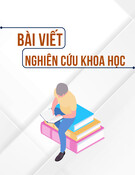
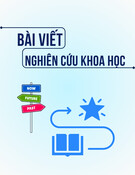
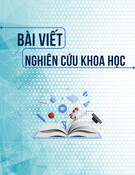
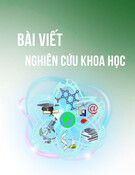
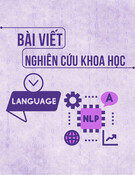






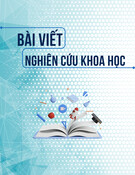

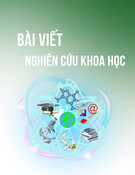

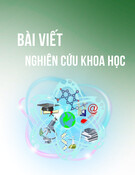


![Định hướng giáo dục STEM trong trường trung học: Tài liệu [chuẩn/mới nhất]](https://cdn.tailieu.vn/images/document/thumbnail/2025/20251124/dbui65015@gmail.com/135x160/25561764038505.jpg)




